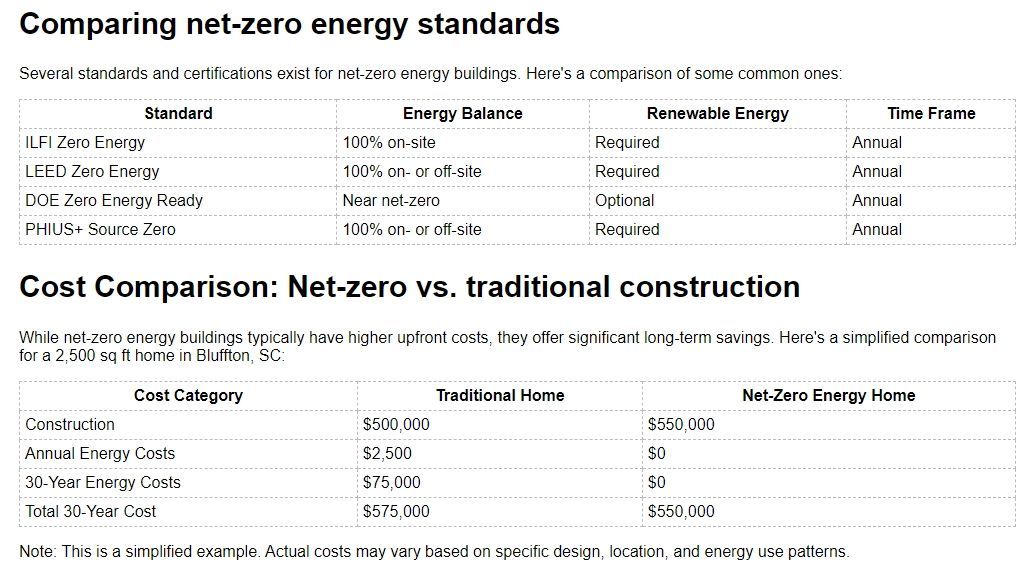Net-zero energy buildings are structures that produce as much energy as they consume over the course of a year. These innovative designs are changing the landscape of sustainable architecture and construction. As a custom home builder and commercial construction company in Bluffton, South Carolina, we're excited about the potential of net-zero energy buildings to reduce carbon footprints and lower energy costs for our clients.
Key takeaways
- Net-zero energy buildings produce as much energy as they use annually
- They combine energy efficiency measures with renewable energy generation
- Solar panels and geothermal systems are common renewable energy sources
- Improved insulation and high-efficiency appliances reduce energy consumption
- Net-zero buildings can lower utility costs and increase property values
- The upfront costs are higher but offer long-term savings
- Government incentives are available to offset initial expenses
- Net-zero designs are becoming more common in both residential and commercial sectors
What are net-zero energy buildings?
Net-zero energy buildings, also called zero energy buildings, are structures designed to produce as much energy as they consume over a year. This balance is achieved through a combination of energy efficiency measures and on-site renewable energy generation.
These buildings are highly insulated and airtight to minimize energy loss. They use energy-efficient appliances, lighting, and HVAC systems to reduce overall energy consumption. To generate power, net-zero buildings typically incorporate renewable energy technologies like solar panels, wind turbines, or geothermal systems.
The benefits of net-zero energy buildings
There are several advantages to constructing net-zero energy buildings:
Lower operating costs
While the upfront costs of building a net-zero energy structure may be higher, the long-term savings on utility bills can be substantial. Homeowners and businesses can significantly reduce or eliminate their electricity costs over time.
Reduced carbon footprint
By generating clean, renewable energy on-site, net-zero buildings help reduce reliance on fossil fuels and lower greenhouse gas emissions. This makes them an important tool in combating climate change.
Increased property value
Net-zero energy homes and commercial buildings often command higher resale values due to their energy efficiency and low operating costs. This can make them attractive investments for property owners.
Improved comfort
The high-performance building envelope and efficient HVAC systems in net-zero buildings often result in more consistent indoor temperatures and better air quality, creating a more comfortable living or working environment.
Energy independence
By generating their own power, net-zero buildings are less vulnerable to utility rate increases and power outages. This can provide peace of mind and stability for building owners.
Key components of net-zero energy buildings
Several essential elements work together to create a net-zero energy building:
High-performance building envelope
A well-insulated and airtight building envelope is crucial for minimizing heat loss in winter and heat gain in summer. This reduces the energy needed for heating and cooling.
Energy-efficient systems
Net-zero buildings use high-efficiency HVAC systems, water heaters, and appliances to minimize energy consumption. LED lighting and smart controls further reduce electricity use.
Renewable energy generation
Solar panels are the most common form of on-site renewable energy generation for net-zero buildings. Some may also use wind turbines or geothermal systems, depending on the location and available resources.
Energy storage
Many net-zero buildings incorporate battery storage systems to store excess energy generated during peak production times for use during periods of low production or high demand.
Smart energy management
Advanced energy monitoring and control systems help optimize energy use and production in net-zero buildings, ensuring they maintain their energy balance over time.
Challenges of net-zero energy construction
While net-zero energy buildings offer many benefits, there are some challenges to consider:
Higher upfront costs
The advanced technologies and high-performance materials used in net-zero buildings can increase initial construction costs. However, these costs are often offset by long-term energy savings.
Design complexity
Creating a net-zero energy building requires careful planning and integration of various systems. This can make the design process more complex and time-consuming.
Site limitations
Not all sites are suitable for net-zero energy buildings. Factors like available sunlight, local climate, and building orientation can impact the feasibility of achieving net-zero status.
Occupant behavior
The energy performance of a net-zero building can be affected by how occupants use the space. Education and ongoing monitoring may be necessary to maintain net-zero status.
Net-zero energy in residential construction
Net-zero energy homes are becoming increasingly popular as homeowners seek to reduce their carbon footprint and energy costs. In Bluffton, South Carolina, we're seeing growing interest in net-zero home designs that incorporate local architectural styles while maximizing energy efficiency.
Design considerations for net-zero homes
When designing a net-zero energy home in Bluffton, we consider several factors:
- Orientation to maximize passive solar heating and cooling
- Roof design to accommodate solar panels
- Window placement and shading to control heat gain
- Local climate conditions and seasonal variations
- Integration of energy-efficient appliances and systems
Examples of net-zero homes in South Carolina
Several net-zero energy homes have been built in South Carolina, showcasing the potential for sustainable living in our climate:
- A LEED Platinum certified home in Charleston that combines solar power with geothermal heating and cooling
- A net-zero energy cottage on Hilton Head Island that blends traditional Lowcountry architecture with modern energy efficiency
- A family home in Columbia that achieves net-zero status through a combination of solar panels, energy-efficient appliances, and smart home technology
Net-zero energy in commercial construction
Commercial buildings are also embracing net-zero energy design, with offices, schools, and retail spaces leading the way. In Bluffton and the surrounding areas, we're seeing increased interest in net-zero commercial projects.
Advantages for businesses
Net-zero energy commercial buildings offer several benefits for businesses:
- Lower operating costs, which can improve profitability
- Enhanced corporate image and sustainability credentials
- Improved employee comfort and productivity
- Potential for higher property values and rental rates
Case study: Net-zero office building in Charleston
A recently completed office building in Charleston demonstrates the potential for net-zero energy in commercial construction:
- 50,000 square foot, four-story building
- Rooftop solar array provides 100% of annual energy needs
- High-performance building envelope with triple-pane windows
- Geothermal heating and cooling system
- LED lighting with daylight harvesting controls
- Achieved LEED Platinum and Net Zero Energy certification
Government incentives for net-zero energy buildings
Various government incentives are available to encourage the construction of net-zero energy buildings:
Federal tax credits
The federal government offers tax credits for renewable energy systems and energy-efficient home improvements. These can help offset the costs of solar panels, geothermal systems, and other net-zero technologies.
State and local incentives
South Carolina offers additional incentives for renewable energy and energy efficiency:
- Solar energy tax credit of 25% of system costs
- Property tax exemptions for renewable energy systems
- Utility company rebates for energy-efficient appliances and upgrades
Green building certifications
While not direct financial incentives, green building certifications like LEED and Energy Star can provide marketing advantages and potential tax benefits for net-zero energy buildings.
The future of net-zero energy construction
As technology improves and costs decrease, we expect to see continued growth in net-zero energy construction. Some trends to watch:
Prefabrication and modular construction
Prefabricated and modular building techniques can help streamline the construction of net-zero energy buildings, potentially reducing costs and improving quality control.
Advanced building materials
New materials like aerogel insulation and phase-change materials may further improve the energy performance of buildings, making it easier to achieve net-zero status.
Integration of electric vehicle charging
As electric vehicles become more common, we expect to see increased integration of EV charging infrastructure in net-zero energy buildings.
Community-scale net-zero projects
Larger-scale net-zero energy developments, including entire neighborhoods or districts, may become more common as cities and developers embrace sustainable design.

Steps to achieve net-zero energy in existing buildings
Retrofitting existing buildings to achieve net-zero energy status is challenging but possible. Here are key steps:
- Conduct an energy audit to identify areas for improvement
- Upgrade insulation and air sealing
- Replace windows and doors with high-performance alternatives
- Install energy-efficient HVAC systems
- Upgrade to energy-efficient appliances and lighting
- Add renewable energy systems like solar panels
- Implement smart energy management systems
- Educate occupants on energy-efficient behaviors
Conclusion
Net-zero energy buildings represent an exciting frontier in sustainable construction. As a custom home builder and commercial construction company in Bluffton, South Carolina, we're committed to helping our clients explore the possibilities of net-zero energy design.
While challenges exist, the long-term benefits of reduced energy costs, increased property values, and a smaller carbon footprint make net-zero energy buildings an attractive option for many homeowners and businesses.
As technology advances and costs continue to decrease, we expect to see net-zero energy buildings become increasingly common in our community and beyond. For more information, you can visit our website or contact us.

